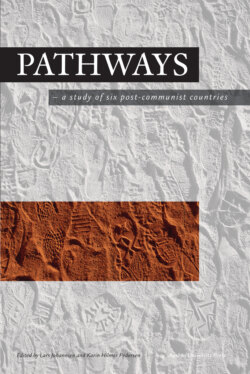Читать книгу Pathways - Группа авторов - Страница 5
На сайте Литреса книга снята с продажи.
CHAPTER 1 After the Wall: Political development trajectories in selected post-communist countries
ОглавлениеLars Johannsen and Karin Hilmer Pedersen
Since The Wall was demolished, the event that symbolised freedom from the Soviet empire and catalysed the implosion of the Soviet Union itself, political developments in what we now call former communist countries have taken various paths. Power has changed hands peacefully by the ballot in Central and Eastern Europe, and the economies have resumed growth after initial contractions. The Baltic States stood out as shining miracles, in stark contrast to several former Soviet republics that plunged into war, civil strife, poverty and outright dictatorship. Harold Macmillan’s 1960 ‘wind of change’ jumped continents, but only Slovenia took the fast track to membership of the European Union after narrowly escaping the atrocities in the wake of the dissolution of Yugoslavia.
In order to trace these various paths of development we build on insights gained during the last fifteen years of studies of transition, democratisation and political development, asking why a feature is decisive for change in one context while not in another; and why one context accords particular incentives and preferences among elites in some countries but not in others. Important though it is in view of the many theoretical debates that revolve around it, democracy should not be seen as the dependent variable. We look instead for the feature that was decisive for the political development in each country in question. We thereby change the focus from the content of the outcome (democracy or not) to the paths chosen by elites. An alternative formulation is: ‘what is the key to understanding the political development of the said country?’
In methodological terms we offer a foundation for (re)constructing an alternative view of transition trajectories in the post-communist space. We do so by deconstructing the ‘keys’ to development into combinations of four interlinked transformation areas: political institutions, economic liberalisation, nation building and state building. Adding to this web of interconnected transformation areas, we discuss how the international context may either reinforce elite positions or constrain decision making.
Tracing the different trajectories of political development in post-communist countries requires a choice of cases from within the post-communist region that exhibit maximum variation in independent variables. We have accordingly selected six countries – Kazakhstan, Georgia, Estonia, Slovenia, the Czech Republic and Poland. The agenda and the cases echo the depths of Valerie Bunce’s comment that post-communist development encompasses virtually ‘all the fundamental issues in politics’ (Bunce 2001, 793), namely [re-]construction of economic and political regimes, decisions about national composition and affiliation of populations, and the state and its capacity to command compliance (to govern) and extract resources. The cases presented here thus truly reflect the ‘comparable cases strategy’ (Landman 2000; Lijphart 1975), in which the outcome is the product of multiple causal factors acting in concert. In strict methodological terms the choice of maximum variation in the constituent independent variables should be followed by a parallel similarity between the outcome and the explanatory factors. However, among our cases Kazakhstan and Georgia are examples of autocracy or semi-authoritarian regimes, whereas the European cases exemplify democratic success, even if they too exhibit fundamental democratic deficits (Ágh 2002; Lewis 2004). Thus, what we are in fact striving for in methodological terms is to compare the incomparable.
In our search for the keys to political development we asked six country specialists to paint a broad picture of what characterises the changes listed above. We asked them to follow the Tocquevillian tradition, a ‘method’ of indirect comparison where in-depth knowledge of a country based on linguistics and history is held up against existing concepts. In this sense, all case studies and empirical descriptions have a comparative core because comparable concepts are applied. Thus, we stress that the manner in which the four transitions are connected and shaped by their positions in the international context provides unique ‘keys’ to understanding the countries in question, and hence we called for contributions that place the choices made by the elites in a socio-economic and historical context.
The following six chapters, each dedicated to one country, constitute the main bulk of this book. The final task of comparing across the cases and discussing different pathways will be dealt with in our concluding chapter. This introductory chapter first gives an overview of the debate and describes the importance and impact of the different transition spheres. Second, we discuss the methodology applied in the final comparative chapter.
